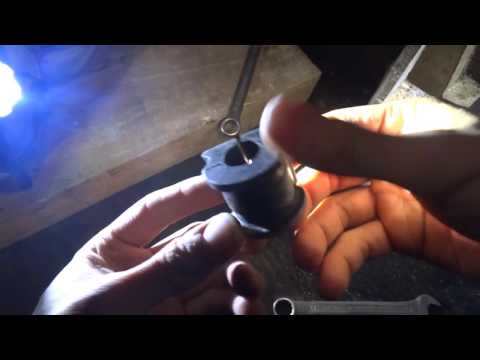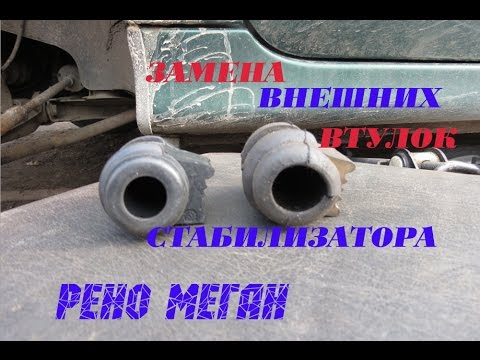
Replacing stabilizer bushings
Content
Stabilizers are responsible for vehicle stability on the road. To eliminate noise and vibration from the operation of the stabilizer components, special bushings are used - elastic elements that give a smooth ride.
What is a bushing? The elastic part is created by casting from rubber or polyurethane. Its shape practically does not change for different models of cars, but sometimes it has some features depending on the design of the stabilizer. in order to improve the performance of the bushings, sometimes they contain tides and grooves. They strengthen the structure and allow the parts to last longer, as well as protect against mechanical stress that can damage them.
When is the cross stabilizer bushings replaced?
You can determine the degree of bushing wear during a routine inspection. Cracks, changes in the properties of rubber, the appearance of abrasions - all this suggests that you need to change the part... Usually, the replacement of the bushings is carried out every 30 km mileage. Experienced owners are advised to change all the bushings at once, regardless of their external condition.
An unscheduled replacement of bushings is necessary when the following symptoms appear:
- backlash of the steering wheel when the car enters corners;
- noticeable beating of the steering wheel;
- body roll, accompanied by characteristic sounds unusual for it (clicks, squeaks);
- vibration in the suspension of the car, accompanied by extraneous noise;
- in a straight line, the car pulls to the side;
- general instability.
Detection of such problems requires urgent diagnosis. Primary attention should be paid to the bushings. By replacing them, you can check the operation of the car, and if signs of breakdown remain, an additional inspection should be carried out.
Replacing the front stabilizer bushings
Regardless of the vehicle model, the general procedure for replacing bushings is the same. Only the tools and some details of the procedure change. Even a novice driver can guess what exactly needs to be done as an additional action.
Front stabilizer bar bush
To replace bushings, follow these steps:
- Place the machine stationary on a pit or lift.
- Using tools, loosen the front wheel bolts.
- Remove the wheels of the vehicle completely.
- Unscrew the nuts securing the struts to the stabilizer.
- Disconnect the struts and stabilizer.
- Loosen the rear bolts of the bracket framing the bushing and unscrew the front ones.
- Using the tools at hand, get rid of the dirt in the place where the new bushings will be installed.
- Using silicone spray or soapy water, thoroughly lubricate the inside of the bushings.
- Install the bushings and perform a series of procedures, reverse of those listed, in order to return the machine to working condition.
Replacing the rear stabilizer bushings is carried out in the same way. The only thing is that removing the front bushings is sometimes more difficult due to the complexity of the car's front design. If the driver succeeds in changing the front bushings, then he will surely cope with replacing the rear bushings.
Often the reason for replacing the bushings is their squeak. This factor, although not critical, still causes inconvenience to many drivers and passengers.
Squeak of stabilizer bushings
Often, car owners complain about the creaking of the stabilizer bushings. Often it appears during the onset of frost or in dry weather. However, the conditions of occurrence are manifested individually.
Causes of squeaks
The main reasons for this problem are:
- poor quality of the material from which the stabilizer bushings are made;
- hardening of rubber in the cold, because of which it becomes inelastic and makes a creak;
- significant wear of the sleeve or its failure;
- design features of the car (for example, Lada Vesta).
Methods for solving the problem
Some car owners try to lubricate the bushings with various lubricants (including silicone grease). However, as practice shows, this only gives temporary effect (and in some cases it does not help at all). Any lubricant attracts dirt and debris, thus forming an abrasive. And this leads to a decrease in the resource of the bushing and the stabilizer itself. Therefore, we do not recommend that you use any lubricants..
In addition, it is also not recommended to lubricate the bushings due to the fact that this violates the principle of their operation. After all, they are designed to tightly hold the stabilizer. Being essentially a torsion bar, it works in torsion, creating resistance to the roll of the car when cornering. Therefore, it must be securely fixed in the sleeve. And in the presence of lubrication, this becomes impossible, since it can now also scroll, while making a creak again.
The recommendation of most auto manufacturers regarding this defect is replacement of bushings. So, the general advice for car owners who are faced with the problem of creaking from the stabilizer is to drive with a creak for a certain time (one to two weeks is enough). If the bushings do not “grind in” (especially for new bushings), they will need to be replaced.
In some cases it helps replacement of rubber bushings with polyurethane. However, this depends on the vehicle and the bushing manufacturer. Therefore, the responsibility for the decision to install polyurethane bushings lies solely with car owners.
To solve the problem, some car owners wrap the part of the stabilizer that is inserted into the bushing with electrical tape, thin rubber (for example, a piece of bicycle tube) or cloth. Genuine bushings (for example, Mitsubishi) have a fabric insert inside. This solution will allow the stabilizer to fit more tightly in the bushing and save the car owner from unpleasant sounds.
Description of the problem for specific vehicles
According to statistics, most often the owners of the following cars encounter the problem of squeaking of the stabilizer bushings: Lada Vesta, Volkswagen Polo, Skoda Rapid, Renault Megan. Let's describe their features and the replacement process:
- Lada Vesta. The reason for the squeaking of the stabilizer bushings on this car is structural feature of the suspension. The fact is that Vesta has a longer stabilizer strut travel than previous VAZ models. Their racks were attached to the levers, while Vesta's were attached to the shock absorbers. Therefore, earlier the stabilizer rotated less, and was not the cause of unpleasant sounds. In addition, Vesta has a large suspension travel, which is why the stabilizer rotates more. There are two ways out of this situation - to shorten the suspension travel (lower the landing of the car), or use a special lubricant (manufacturer's recommendation). It is better to use a wash-resistant lubricant for this purpose, silicone based... Do not use lubricants that are aggressive towards rubber (also do not use WD-40).

Replacing stabilizer bushings for Volkswagen Polo
- Volkswagen Polo. Replacing the stabilizer bushings is not difficult. To do this, you need to remove the wheel and install the car on a support (for example, a wooden structure or a jack), in order to relieve tension from the stabilizer. To dismantle the bushing, we unscrew the two 13 bolts that secure the mounting bracket of the bushing, after which we take it out and take out the bushing itself. Assembly is carried out in reverse order.
Also, one common way to get rid of squeaks in Volkswagen Polo bushings is to place a piece of an old timing belt between the body and the bushing. In this case, the teeth of the belt should be directed towards the bushing. At the same time, it is necessary to produce small reserves over the area from all sides. This procedure is performed for all bushings. The original solution to the problem is the installation of bushings from Toyota Camry.
- Skoda Rapid... According to numerous reviews of the owners of this car, it is best to put original VAG bushings. According to statistics, most owners of this car do not have problems with them. Many owners of the Skoda Rapid, like the Volkswagen Polo, simply put up with a slight squeak of the bushings, considering them to be “childhood diseases” of the VAG concern.
A good solution to the problem would be the use of so-called repair bushings, which have a diameter of 1 mm less. Bushing catalog numbers: 6Q0 411 314 R - inner diameter 18 mm (PR-0AS), 6Q0 411 314 Q - inner diameter 17 mm (PR-0AR). Sometimes car owners use bushings from similar Skoda models, such as Fabia.
- Reno Megan. Here the procedure for replacing the bushings is similar to that described above.

Replacing stabilizer bushings on Renault Megane
First you need to remove the wheel. After that, disconnect the bracket, for which unscrew the fixing bolts and remove the fixing bracket. To work, you will need a pry bar or a small crowbar that is used as a lever. After dismantling the structure, you can easily get to the sleeve.
It is recommended to clean its seat from rust and dirt. Before installing a new bushing, it is advisable to lubricate the surface of the stabilizer at the installation site and the bushing itself with some kind of detergent (soap, shampoo) so that the bushing is easier to put on. The assembly of the structure takes place in the reverse order. note that Renault Megane has a regular and reinforced suspension... Accordingly, different diameters of the stabilizer and their sleeves.
Certain automakers, such as Mercedes, produce stabilizer bushings, equipped with anthers. They protect the inner surface of the sleeve from water and dust ingress. Therefore, if you have the opportunity to buy such bushings, we recommend that you produce it.
It is recommended to lubricate the inner surface of the bushings with greases that do not destroy rubber. namely, based on silicone. For example, Litol-24, Molykote PTFE-N UV, MOLYKOTE CU-7439, MOLYKOTE PG-54 and others. These greases are multipurpose and can also be used to lubricate brake calipers and guides.

